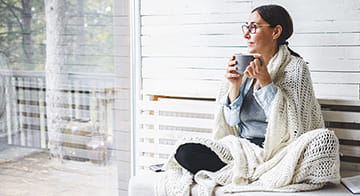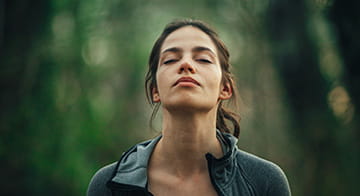No matter where we reside in the world, the simple pleasure of basking in the sun's warmth and savouring the outdoors is a joy for many of us. Sunlight offers numerous health benefits, playing a vital role in the production of vitamin D, which is essential for healthy bones, a strong immune system and positive mental well-being.1
However, it's important to find a balance between reaping the benefits of the sun and safeguarding ourselves from potential risks. Excessive exposure to the sun's harmful ultraviolet (UV) radiation can lead to skin damage, premature aging, and an increased risk of skin cancer.2 Understanding how to protect our skin and prevent heat-related illnesses is essential for a safe and enjoyable experience under the sun.
We will explore the health benefits of sunlight, potential risks associated with excessive sun exposure, and provide practical tips for how to stay safe and well in the sun. Whether you're planning a beach day, engaging in outdoor activities, or simply taking a leisurely stroll, this article will provide you with the knowledge and strategies to make informed choices about sun safety.
Health benefits of being in the sun
Spending time in the sun offers many health benefits. It stimulates the production of vitamin D, which plays a vital role in maintaining our overall health. Vitamin D is essential for numerous bodily functions, including supporting bone health and helping guard against inflammation.3
According to Dr Naveen Puri, Medical Director Bupa UKI, "Vitamin D is crucial for our health, as it helps our bodies absorb calcium and maintain strong and healthy bones. It also plays a significant role in supporting our immune system, helping to protect against various illnesses and infections."
"Sunlight exposure triggers the release of serotonin, a neurotransmitter known as the 'happy hormone,' which plays a crucial role in regulating mood and promoting a sense of well-being. This can have a positive impact on our mental state, helping to alleviate symptoms of seasonal affective disorder and enhancing overall emotional balance."
– Dr Naveen Puri
Researchers have conducted studies that highlight the potential health benefits of sun exposure beyond the production of vitamin D. For example, exposure to sunlight has been linked to lower blood pressure levels which in turns leads to reduced death rates from cardiovascular issues. Additional research suggests that healthy amounts of sun exposure may offer some protection against certain diseases including include type 1 diabetes, multiple sclerosis (MS), as well as various forms of cancer such as colon, breast, and prostate cancer, and non-Hodgkin lymphoma.4
What’s more, there is a connection between sunlight and emotional wellbeing. Dr Naveen explains, "Sunlight exposure triggers the release of serotonin, a neurotransmitter known as the 'happy hormone,' which plays a crucial role in regulating mood and promoting a sense of wellbeing. This can have a positive impact on our mental state, helping to alleviate symptoms of seasonal affective disorder and enhancing overall emotional balance."
In addition to its influence on mental wellbeing, spending time in the sun has also been associated with improved sleep patterns. Dr Naveen notes, "Sunlight exposure helps regulate our body's internal clock, known as the circadian rhythm, which governs our sleep-wake cycle. By exposing ourselves to natural light during the day, especially on or soon after waking up, we can enhance our circadian rhythm, leading to more restful and rejuvenating sleep at night."
The risks of excessive sun exposure
While enjoying the sun's warmth and beauty, it is important to be aware of the potential risks associated with excessive sun exposure.
Excessive sun exposure can lead to various types of skin damage, including sunburn, premature aging, and an increased risk of skin cancer. Ultraviolet (UV) radiation penetrates the skin and can cause DNA damage to skin cells, increasing the chances of mutations and the development of cancerous cells over time. Dr Naveen explains, "Both UVA and UVB rays from the sun can contribute to skin damage and the formation of skin cancer. It is important to protect our skin from these harmful rays."
Dr Naveen continues “Prolonged and unprotected exposure to the sun can accelerate skin aging, leading to the appearance of wrinkles, fine lines, and age spots. UV radiation breaks down collagen and elastin fibres in the skin, which are responsible for maintaining its elasticity and youthful appearance.”
What is sunburn?
Sunburn, a common consequence of excessive sun exposure, is characterised by a red appearance on lighter-skin, and hot, irritating, itchy, and sometimes painful, blistered skin on both darker and lighter skin types. Sunburn not only causes discomfort but also indicates damage to the skin cells.
Practical sun safety tips
To stay safe and well in the sun, Dr Naveen advises that people follow some simple guidelines:
- Protection: Apply sunscreen with a high sun protection factor (SPF) to all exposed skin. Choose a broad-spectrum sunscreen that protects against both UVA and UVB rays. Additionally, wear a wide-brimmed hat to shade your face, neck, and ears from the sun. Don't forget to wear sunglasses to protect your eyes from harmful UV rays. Wear lightweight and breathable clothing that covers your skin to minimise direct sun exposure
- Timing: Avoid the hottest part of the day, typically between 10 a.m. and 4 p.m. depending on where you are in the world, as this is when the sun's rays are their strongest. If possible, plan your outdoor activities for early mornings or evenings when the sun is less intense. This reduces your risk of sunburn and overexposure to UV radiation.
- Hydration: Stay hydrated by drinking plenty of water throughout the day, even if you don't feel thirsty. The heat from the sun can cause dehydration, so it's essential to replenish your body with fluids regularly. Carry a water bottle with you and take sips frequently to maintain hydration.
- Seek shade: Shade provides an extra layer of protection from direct sun exposure. If shade is limited, create your own using umbrellas, canopies, or sun shelters. This can help reduce your overall exposure and minimise the risk of sunburn.
- Cloudy/windy days: Don't be fooled by cloudy or windy weather. The sun's UV rays can still penetrate through clouds and cause sunburn. It’s important to apply sunscreen and follow sun safety precautions even on days when the sun isn't shining brightly.
- Know your activity: Consider the type of activity you'll be undertaking in the sun. If you're engaging in water sports or activities, choose water-resistant sunscreen and reapply it regularly as instructed. If you're participating in sports or physical activities, make sure your clothing allows for ease of movement and provides adequate sun protection.
- Be aware of the UV index: Check the UV index for the day before heading outdoors. The UV index provides information about the intensity of the sun's UV radiation. Plan your activities accordingly and take extra precautions if the UV index is high. Adjust your sun protection measures accordingly by applying sunscreen more frequently and seeking shade whenever possible.
Sun safety for everyone
Maintaining sun safety is crucial for everyone. And while each person's needs may vary, these guidelines provide a foundation for protecting against the sun’s rays in a variety of common situations:
Exercise outdoors: When exercising outside, take into consideration your individual tolerance to sun exposure. Choose early mornings or evenings for your workouts when the sun's intensity is lower. It's recommended to wear lightweight and breathable clothing that covers your skin. Don't forget to apply sunscreen with a high sun protection factor (SPF) to exposed areas and stay hydrated by drinking plenty of water.
Commuting in hot weather: If you're travelling in hot weather, adapt your sun safety practices accordingly. Use shaded routes or public transportation whenever possible. Wear a wide-brimmed hat and sunglasses to shield yourself from direct sunlight. Apply sunscreen to exposed skin and ensure you stay hydrated throughout your journey by carrying a water bottle.
Work travel to sunny destinations: Remember to pack essential items such as a high SPF sunscreen, a wide-brimmed hat, and lightweight clothing that covers your skin. Take breaks in shaded areas to avoid overexposure to the sun. Adjust your sun safety measures based on the local climate and sun intensity.
Everyone's different: It's important to recognise that everyone's sun sensitivity and tolerance levels may vary. Some individuals may burn more easily, while others may be more resilient to sun exposure. Consider your skin type, age, medical conditions, and medications that may increase your sensitivity to the sun. Tailor your sun safety practices to your individual needs.
Consult with a healthcare professional: If you have specific concerns or questions about sun safety, it's advisable to consult with a healthcare professional. They can provide personalised advice based on your unique circumstances and help you establish an appropriate sun protection routine.
Sun safety is a responsibility we all share. By taking proactive measures to protect ourselves from excessive sun exposure, we can reduce the risk of sunburn, skin damage, and potential long-term effects such as skin cancer. Prioritising sun safety ensures that everyone can enjoy the outdoors while minimising the harmful effects of the sun's rays.



